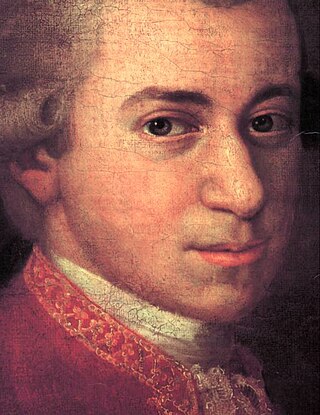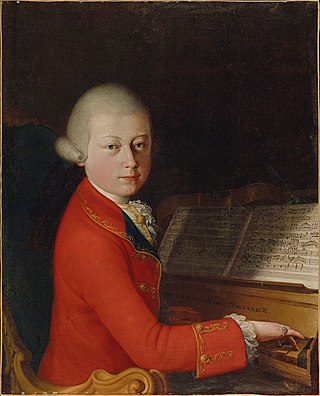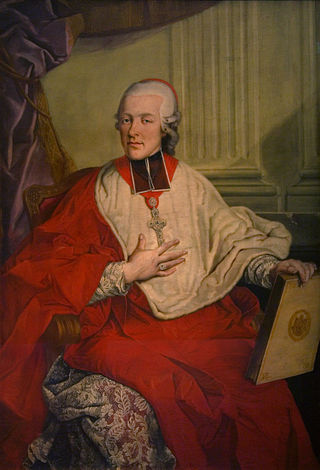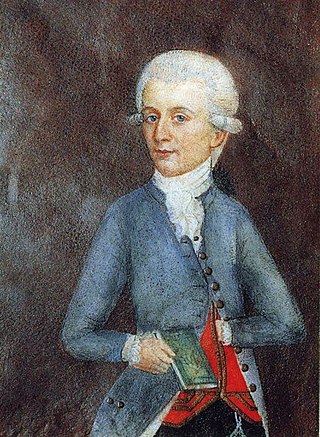
Symphony No. 18 in F major, K. 130, was the last of three symphonies composed by Wolfgang Amadeus Mozart in May 1772, when he was sixteen years old. [1]

Symphony No. 18 in F major, K. 130, was the last of three symphonies composed by Wolfgang Amadeus Mozart in May 1772, when he was sixteen years old. [1]
The symphony is scored for two flutes, two horns in C and two horns in F for the first, third and fourth movements, in F and B-flat for the second, and strings. There are no oboes in this symphony; Mozart used flutes instead for the first time. Mozart also used a second pair of horns throughout this work, which is a rarity in his oeuvre. [1]

There are four movements:

Symphony No. 20 in D major, K. 133, was composed by Wolfgang Amadeus Mozart in July, 1772, when Mozart was sixteen years old. This symphony is one of many written during the period Mozart stayed in Salzburg, between two trips to Italy. Compared to other symphonies Mozart wrote in this period, the scoring is extravagant, featuring two trumpets in addition to the standard oboes, horns, and strings. The key of D major, which is a key often reserved for ceremonial music, is well suited to the presence of these trumpets.

Symphony No. 14 in A major, K. 114, is a symphony composed by Wolfgang Amadeus Mozart on December 30, 1771, when Mozart was fifteen years old, and a fortnight after the death of the Archbishop Sigismund von Schrattenbach. The piece was written in Salzburg between the composer's second and third trips to Italy. Mozart was also influenced by J. C. Bach's "Italianate" style of composition".

The Serenade No. 10 for winds in B-flat major, K. 361/370a, is a serenade by Wolfgang Amadeus Mozart scored for thirteen instruments: twelve winds and string bass. The piece was probably composed in 1781 or 1782 and is often known by the subtitle Gran Partita, though the title is a misspelling and not in Mozart's hand. It consists of seven movements.

Symphony No. 9 in C major, K. 73/75a, by Wolfgang Amadeus Mozart, has an uncertain provenance. The most likely date of its composition appears to be late 1769 or early 1770 during Mozart's first Italian journey, although some authorities have dated it "probably not before early summer 1772". It may have been started in Salzburg, before the first Italian journey began, and completed during the trip.

Wolfgang Amadeus Mozart wrote Symphony No. 30 in D major, K. 202/186b in Salzburg, completing it on May 5, 1774.

Symphony No. 19 in E-flat major, K. 132, is a symphony composed by Wolfgang Amadeus Mozart in July 1772.

Symphony No. 21 in A major, K. 134, is a symphony that was composed by Wolfgang Amadeus Mozart in August 1772.

Symphony No. 22 in C major, K. 162, is a symphony composed by Wolfgang Amadeus Mozart in April 1773. The symphony has the scoring of two oboes, two horns in C, two trumpets in C, and strings.

Symphony No. 24 in B-flat major, K. 182/173dA, is a symphony composed by Wolfgang Amadeus Mozart, completed in Salzburg on 3 October 1773. The symphony is scored for 2 oboes, 2 horns in B-flat, and E-flat for the second movement, and strings.

Symphony No. 27 in G major, K. 199/161b, is a symphony composed by Wolfgang Amadeus Mozart in April, 1773. The symphony is scored for 2 flutes, 2 horns, and strings.
The six string quartets, K. 168–173, were composed by Wolfgang Amadeus Mozart in late 1773 in Vienna. These are popularly known as the Viennese Quartets. Mozart may have hoped to have them published at the time, but they were published only posthumously by Johann André in 1801 as Mozart's Op. 94.
Divertimento No. 11 or Divertimento in D, K. 251, is a composition by Wolfgang Amadeus Mozart. It was written in July 1776 in Salzburg, possibly for the name day of Mozart's sister, Nannerl on July 26 or her birthday on July 30. The work is scored for oboe, two horns, two violins, viola and double bass.
The Serenade No. 5 in D major, K. 204/213a was written on 5 August 1775 by Wolfgang Amadeus Mozart for ceremonies at the University of Salzburg. The work is very similar to the serenade K. 203, composed for Salzburg the previous summer.

The Serenade No. 4 in D major, K. 203/189b was written in August 1774 by Wolfgang Amadeus Mozart for ceremonies at the University of Salzburg. It is nicknamed Colloredo after Mozart's patron, Count Hieronymus von Colloredo. The work is very similar to the serenade K. 204 composed for Salzburg the following summer.
Felix Mendelssohn wrote thirteen string symphonies between 1821 and 1823, when he was between 12 and 14 years old.. These symphonies were tributes to Classical symphonies especially by Joseph Haydn, Johann Christian Bach, Carl Philipp Emanuel Bach, and Wolfgang Amadeus Mozart.
The Symphony in F major "No. 42", K. 75, was written by Wolfgang Amadeus Mozart probably around March to August 1771 in Salzburg.
The Symphony in D major "No. 51", K. 196+121 (207a, was composed by Wolfgang Amadeus Mozart in 1774–1775. The first two movements are from the overture to the opera La finta giardiniera, K. 196, and the last movement, K. 121/207a, was composed separately in 1775.

The Divertimento No. 15 in B-flat major, K. 287, is a divertimento for two horns and strings by Wolfgang Amadeus Mozart. He composed the work in six movements in 1777 for the name day of Countess Maria Antonia Lodron. It is also known as the Lodronische Nachtmusik Nr. 2.
The divertimenti in F major, B-flat major, E-flat major, F major, and B-flat major are five companion compositions for pairs of oboes, horns and bassoons by Wolfgang Amadeus Mozart.